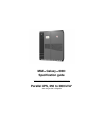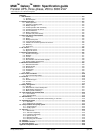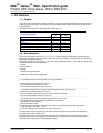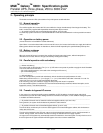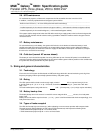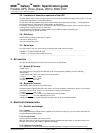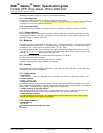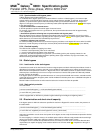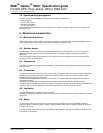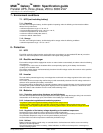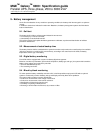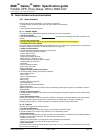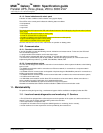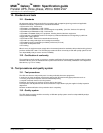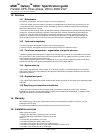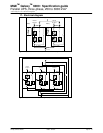
MGE
TM
Galaxy
TM
6000 : Specification guide
Parallel UPS, three-phase, 250 to 3000 kVA*
* Power rating for an N+1 redundant configuration
APC By Schneider Electric Edition - 03/2009 Spec. E - 4
2 - Operating principle
The double-conversion UPS (also called on-line) shall operate as defined below.
2.1 - Normal operation
(normal AC source available)
The rectifier supplies the inverter with DC current while the charger simultaneously float charges the battery. The
load is continuously supplied with dependable electrical power by the inverter.
(
)
for parallel connection with a centralized bypass cabinet, up to six units)
A current-loop system shall ensure automatic distribution of the total load between the various parallel-connected
units.
2.2 - Operation on battery power
(normal AC source not available or outside tolerances)
Upon failure or excessive deterioration of the normal AC source, the inverter shall continue to supply the load from
battery power without interruption or disturbance, within the limits imposed by the specified battery backup time.
2.3 - Battery recharge
(normal AC source restored)
When the normal AC source is restored, the rectifier shall again power the inverter, without interruption or
disturbance to the load, while the charger automatically recharges the battery.
2.4 - Parallel operation with redundancy
………………………………………………………………………………………………………………………………….
(
)
without redundancy)
The system shall not be redundant. The [ 2 / 3 / 4 ] UPS units must operate in parallel to supply the load. Shutdown
of one unit shall result in transfer to
…[ the various static bypasses, connected to the same bypass AC source ]
…[ the centralized bypass ]
…………………………………………………………………………………………………………………………………..
(
)
with redundancy)
The units shall operate in parallel and redundantly, with the load shared equally between the units.
Redundancy shall be of the "n+1" (or n+2) type, i.e. "1" (or 2) units shall be redundant in the total of n units. If a
major fault occurs on a unit, it shall automatically disconnect.
If the remaining unit(s) are sufficient to supply the load, it/they shall remain in operation.
If the total available power is insufficient, the load shall be automatically transferred, without interruption, to the
bypass AC source, if it is within tolerances.
…………………………………………………………………………………………………………………………………..
2.5 - Transfer to bypass AC source
In the event of an overload exceeding system capabilities or UPS shutdown, the static bypass switch shall
instantaneously transfer the load to the bypass AC source without interruption, on the condition that bypass power
is available and within tolerances.
…………………………………………………………………………………………………………………………………..
(
)
for parallel connection with an external maintenance-bypass cabinet, up to four units)
During transfer, the system shall simultaneously switch the static switches.
…………………………………………………………………………………………………………………………………..
(
)
for parallel connection with a centralized-bypass cabinet, up to six units)
Transfer shall be carried out by the common static bypass in the centralized-bypass cabinet, with simultaneous
orders to the UPS units.
………………………………………………………………………………………………………………………………….
Transfer of the load back to the UPS-unit output, synchronised with the bypass AC source, shall be automatic or
manual. During transfer, the load shall not suffer an outage or disturbance in the supply of power.
On request, the UPS system may automatically transfer the load with a micro-interruption if a major fault occurs on
the UPS system and if synchronisation with the bypass source has not been established.



